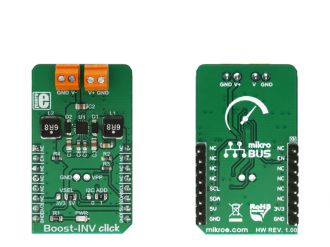
We strongly encourage users to use Package manager for sharing their code on Libstock website, because it boosts your efficiency and leaves the end user with no room for error. [more info]

Rating:
Author: MIKROE
Last Updated: 2018-08-15
Package Version: 1.0.0.0
mikroSDK Library: 1.0.0.0
Category: Boost
Downloaded: 5053 times
Not followed.
License: MIT license
Boost-INV click is a very useful DC/DC voltage converter device, as can output both positive and negative voltage, boosted up to 12.78V and -13.95, from a single fixed voltage input.
Do you want to subscribe in order to receive notifications regarding "Boost-INV click" changes.
Do you want to unsubscribe in order to stop receiving notifications regarding "Boost-INV click" changes.
Do you want to report abuse regarding "Boost-INV click".


Library Description
Library initializes and defines I2C bus driver and driver functions which offer a choice to write data in registers and to read data from registers. The library includes the function for sets positive and negative output voltage and function for enable chip. The user has to set a positive voltage from 3200mV to 12750mV with a step of 50mV and set the negative voltage from -1200mV to -13950mV with a step of 50mV.
Key functions :
void boostinv_setPositiveVoltage(uint16_t voltage) - Functions which set the positive output voltagevoid boostinv_setNegativeVoltage(int16_t voltage) - Functions which set the negative output voltagevoid boostinv_enable() - Functions for enable chipExample description
The application is composed of three sections :
void applicationTask()
{
// Sets Positive output voltage
Positive_Vout = 3200;
boostinv_setPositiveVoltage(Positive_Vout);
Delay_ms( 5000 );
Positive_Vout = 7750;
boostinv_setPositiveVoltage(Positive_Vout);
Delay_ms( 5000 );
Positive_Vout = 12000;
boostinv_setPositiveVoltage(Positive_Vout);
Delay_ms( 5000 );
Positive_Vout = 7750;
boostinv_setPositiveVoltage(Positive_Vout);
Delay_ms( 5000 );
// Sets Negative output voltage
Negative_Vout = -1450;
boostinv_setNegativeVoltage(Negative_Vout);
Delay_ms( 5000 );
Negative_Vout = -6700;
boostinv_setNegativeVoltage(Negative_Vout);
Delay_ms( 5000 );
Negative_Vout = -11050;
boostinv_setNegativeVoltage(Negative_Vout);
Delay_ms( 5000 );
Negative_Vout = -6700;
boostinv_setNegativeVoltage(Negative_Vout);
Delay_ms( 5000 );
}
Other mikroE Libraries used in the example:
Additional notes and information
Depending on the development board you are using, you may need USB UART click, USB UART 2 click or RS232 click to connect to your PC, for development systems with no UART to USB interface available on the board. The terminal available in all MikroElektronika compilers, or any other terminal application of your choice, can be used to read the message.